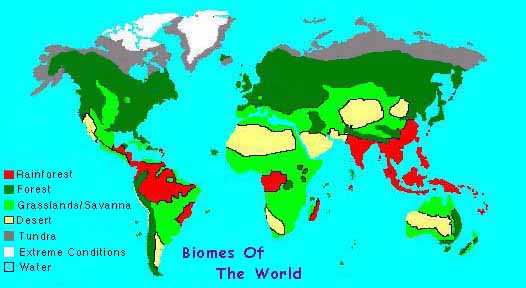
Life on earth is powered by the sun. The earth is illuminated with
roughly 350 W/m2 of sunlight. Sunlight and biological growth work together
as a
functioning ecosystem in order to bind energy into organic material.
Of
the solar energy that reaches the earth's surface, only a very small
fraction is actually transformed into living systems. While this
fraction
may be small, many billions of metric tons of matter per year are
produced
on a global scale.













| |
|
|
|
||||
| Rainforest | 24.5 | 1900 | 46550 | 2.680 x 10-3 | 40.000 | 980.000 | 21.05 |
| Forest | 24 | 1100 | 26400 | 1.552 x 10-3 | 28.300 | 679.200 | 25.73 |
| Grassland/Savanna | 32.5 | 730 | 23832 | 1.030 x 10-3 | 3.900 | 126.750 | 5.34 |
| Cultivated Land | 14 | 650 | 9100 | 9.173 x 10-4 | 1.000 | 14.000 | 1.54 |
| Tundra | 8 | 140 | 1120 | 1.975 x 10-4 | 0.600 | 4.800 | 4.29 |
| Desert | 18 | 90 | 1620 | 1.270 x 10-4 | 0.700 | 12.600 | 7.78 |
| Extreme Conditions | 24 | 3 | 72 | 4.233 x 10-6 | 0.020 | 0.480 | 6.67 |
| Algae/Reefs | 0.6 | 2500 | 1500 | 3.528 x 10-3 | 2.000 | 1.200 | 0.80 |
| Estuaries | 1.4 | 1500 | 2100 | 2.117 x 10-3 | 1.000 | 1.400 | 0.67 |
| Lakes, Swamps, Rivers | 4 | 1125 | 4500 | 1.587 x 10-3 | 7.510 | 30.040 | 6.68 |
| Continental Shelf | 26.6 | 360 | 9576 | 5.080 x 10-4 | 0.010 | 0.266 | 0.03 |
| Ocean | 332 | 125 | 41500 | 1.760 x 10-4 | 0.003 | 0.996 | 0.02 |
| Total | 510 | 10226 | 167870 | 85.000 | 1851.700 | ||
| Rainforest | 18 | 27 | 27 | 1000 | 2500 |
| Forest | -2 | 22 | 13 | 750 | 1500 |
| Grassland/Savanna | 2 | 27 | 16 | 250 | 400 |
| Cultivated Land | 15 | 28 | 19 | 80 | 400 |
| Tundra | -50 | 12 | 8 | 20 | 250 |
| Desert | 21 | 38 | 15 | 0 | 250 |
| Extreme Conditions | -50 | 38 | 0 | 0 | 25 |
Acknowledgements for the photos
Data Analysis: Bridget Smith
Web Design: Katie Strong